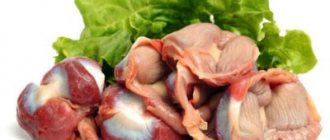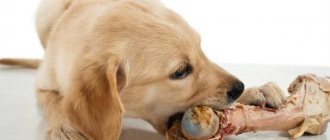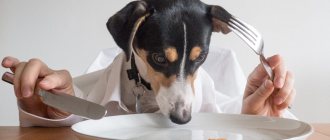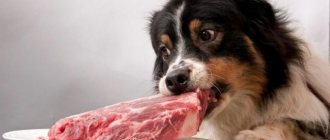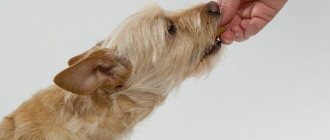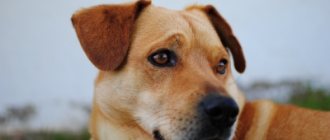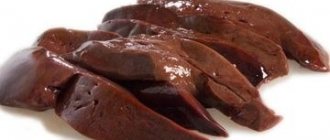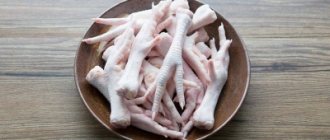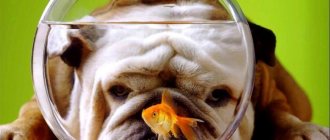Meat is what will always be at the forefront of a dog’s natural diet. Feeding your pet pure beef or even chicken is not cheap, especially if the pet is large and has a good appetite.
Is it possible to replace meat with offal? What are the benefits of chicken heads? Can they harm your pet? Read our article!
Benefits of offal
- The most valuable thing is the brain, which contains vitamin B12 in large quantities. It helps normalize the functioning of the nervous and muscular systems and activates the production of antibodies.
- There is little protein in the heads (only 17% per 100 g of offal), but this also has a positive effect on the development of the dog.
- The skull contains calcium, which is necessary to strengthen the structure of bones and teeth.
There are no tubular bones in the chicken's head, which are dangerous for the dog's esophagus, and breeders are often interested in whether this offal can be given to their pet. There is no particular prohibition, but it is worth considering some negative aspects.
Should I give it to my pet or not?
The dog's diet should be based on animal proteins, which are found in natural food. For pets, lean meat is suitable, which may contain cartilage and tendons, as well as a small amount of fat. Some meat can be replaced with offal, which includes animal entrails, ears, lips, blood, udder, and bone offal. The legs, joints, heads and bones after cutting the carcass contain protein, which has low biological value, but also a lot of fat. When feeding puppies with bone by-products, you need to add food with a high protein content.
Chicken by-products, such as entrails, paws, skin, bones, heads, necks, skeletons with fat trimmings, have a high energy value and are liked by four-legged pets. Chicken meat rarely causes an allergic reaction in dogs, so it can be used when creating a dietary menu.
Chicken bones
As soon as a puppy appears in the house, the first question that arises is about feeding it. A young body requires a variety of nutrients that are essential for the developing body. Bones are the most important product for puppies; they contain building materials such as protein, calcium, lime, glue, etc. It is useful for young dogs to chew on bones, especially when teeth change between the ages of 4 and 6 months, this speeds up the change process.
Animal bones are useful as a source of calcium. Its meat contains little, more phosphorus, and calcium is more beneficial for dogs than phosphorus. Calcium contained in bones is easily absorbed. If bones are regularly present in the dog’s diet, there is no need for additional calcium supplementation. Bones should be given raw. Gastric juice dissolves them, and they become a source of natural calcium and phosphorus, as well as substances that are material for the formation of joint cartilage. But chicken tubular bones are strictly contraindicated!
It is especially dangerous if the dog has eaten enough boiled bones; when cooked, all the nutrients are removed from them, they change their structure and when they enter the stomach they simply turn into dust.
Long bones are very dangerous, especially for small breeds of dogs. They are fragile and, when chewed, break into sharp pieces that can damage the animal's esophagus, which is why they should not be given.
Bones should not be given as the main food: they are poorly digested and can cause constipation, intestinal obstruction, and volvulus. In adult dogs, bones are quickly worn down by teeth. If a dog has eaten tubular bones, you need to monitor it; if any problems arise, you should immediately consult a doctor.
Soft bones can be given as a treat after your dog has eaten a hearty dinner. A well-fed dog will not greedily gnaw on them, but can prolong its pleasure by savoring the bone for a long time.
Chicken heads
If the dog is not allergic to chicken by-products, then you can feed it chicken heads. Raw heads need to be cut into several particles, add porridge or vegetables with vegetable oil to them. At the same time, there are no tubular bones in the heads, which are harmful to four-legged pets. The only thing is that the beaks should be removed, they have no value, they are not digested. If a dog has eaten heads with beaks, they can cause the animal to burp.
Sorry, there are no surveys available at this time.
Chicken necks
Puppies from the age of two months can be given necks either whole or in the form of minced meat. It is advisable to scald raw necks with boiling water. However, you should not feed them more than three times a week. While there is a danger from small bones in the paws and wings, there are no bones in the necks, so you can safely feed even small dogs. Pets enjoy chewing on them. Adult animals can also be fed chicken necks 1-2 times a week.
Necks can be given to clean teeth and massage gums.
Chicken feet
There are many opinions both for and against. Many people give the paws raw; they are then easily digested by the dog, although the claws must be removed. There is an opinion that it is better to give chicken feet in the form of jellied meat, which will even be useful for growing puppies. If you regularly feed puppies jellied meat, it can replace industrial chondroprotectors.
Preparing jellied meat is not difficult. Place the paws in a thick-walled pan and fill them with water. Bring to a boil, and then, reducing the heat to low, cover the pan with a lid and cook for 5 hours. After cooking, you need to remove the bones, leaving the soft tissue. When the jellied meat has cooled down, you can give it to your pet. Boiled bones should not be given to avoid blockage of the gastrointestinal tract and punctures of the esophagus.
Paws consist of tubular bones, this is one of the reasons why many dog breeders do not give them as food to their pets. If the dog has eaten tubular bones, then you need to monitor its feces. If bloody traces are found, you need to contact a veterinary clinic.
Some dog owners feed their pets paws and porridge all the time, but this should not be done. You cannot feed only paws; they can be given as additional food, but not often, since a lot of toxins and waste accumulate in the bones. The diet should be varied so that the animal receives all the nutrients. When giving raw chicken feet, it is advisable to pour boiling water over them, as they can be dangerous.
Veterinarians' opinions also vary. Australian veterinarian Ian Billinghurst conducted research according to which he found that dogs eating natural food live longer than their counterparts eating food. In his book, he bases his conclusions on the fact that the dog is a carnivore with strong teeth for chewing and tearing meat. In addition, it has a short digestive tract, which contains enzymes that help digest raw animal protein. Therefore, Billinghurst recommends feeding meat bones, such as turkey and chicken wings, as well as necks.
By-products are fed to dogs in kennels. Chicken by-products contain a large amount of collagen, for example, in necks and wings - 20-30%, in paws - 60-70% of the total protein. In heads and paws, digestible protein is 12.3%, and fat is 6.8%. Since chicken fats quickly oxidize even at low temperatures, offal can be stored for no more than 3-4 months. To reduce the risk of contracting infectious diseases, it is better to boil offal or scald it with boiling water.
Veterinarians believe that dogs are different and the reaction of each organism to raw meat products is individual due to the characteristics of the gastrointestinal tract. Therefore, in each case you need to decide personally what food to give your pet.
If the dog was fed dry food from birth, then when switching to chicken by-products, vomiting and diarrhea may occur, since natural food requires more gastric juice than dry food. Therefore, the transition to natural food should be gradual. If the dog ate the food and burped, there is no need to do anything in this case; you can even let the dog eat what it burped.
What to look for when purchasing
| Characteristic | Signs |
| View | It is recommended to buy offal not from adult birds, but from broiler chickens. Their bones are softer, easier to chew and faster to digest. |
| State | You should not buy a frozen product - it is so difficult to determine the degree of freshness. The best option is chilled heads |
| Color | High-quality meat is painted in a soft pink hue. Heads must be clean, free from green or blue. |
| Smell | Good offal smells exclusively like fresh meat. There should be no sulfuric or putrid amber present. |
When buying offal for dogs, you should not make it the basis of their diet. But periodically, 1-2 times a week, you can introduce heads into the menu as a dietary supplement.
Are bones good for dogs?
This food is only useful if used correctly.
Why you should give:
- Tendon ligaments and muscles. This is necessary for training the animal’s chewing apparatus (offer it to your pet once every 1–1.5 weeks).
- Cartilaginous tissues have a hard surface and help clean tooth enamel from plaque and deposits containing pathogenic microorganisms.
- The bones contain bone marrow inside. It is rich in animal proteins and is a valuable nutritional supplement. Thanks to its consumption, the pet’s body is saturated with a whole complex of fatty amino acids.
- Bones contain useful microelements (magnesium, calcium, phosphorus) necessary for proper nutrition of the pet.
- Monotonous chewing and gnawing gives the dog the opportunity to occupy himself, calm down, take a break from one activity and switch to another.
- Safety of furniture and shoes. By chewing bones, the dog will not encroach on things in the house.
Can all breeds be given chicken heads?
What breed of dog can be fed with heads is a question many owners face.
Experts assure that there are no restrictions on the type of animal . More attention should be paid to the health of the pet.
When is the best time to abstain and not give in?
If the animal has a predisposition to allergic reactions, then heads should be included in the menu with caution, after consulting with a veterinarian.
This type of by-product is recommended for racing and hunting breeds. Calcium and cyanocobalamin are especially important for them - a component that allows them to avoid anemia.
Briefly about the main thing
- Chicken bones injure the internal organs of dogs, which can cause the death of a pet;
- There are no nutrients in the bones; they will not satisfy your hunger;
- An adult dog should not constantly chew on something;
- A dog can brush its teeth with treats or toys from a pet store;
- Beef and pork bones are included in the permitted list;
- Allowed foods can only be given raw;
- Turkey, rabbit and fish are just as harmful as chicken;
- First aid is the “candle method”: wax “neutralizes” sharp corners;
- If you see blood in your vomit or feces, call your veterinarian.
Feeding taking into account the characteristics of the body
Animals are divided not only into breeds, but also into gender. When choosing a menu for a pet, the characteristics of the body, the condition of the animal and its age are taken into account.
Feeding the puppies
Heads can be introduced into the diet of babies as soon as the sucklings are weaned from the mother's breast.
But for puppies at this stage, the offal is given exclusively in boiled and ground form, after removing the beaks. You can give crushed heads to teenagers.
Pregnant and lactating dogs
During pregnancy or lactation, heads can be included in the diet in any form. For safety, it is advisable to treat the raw offal with boiling water.
The composition is useful for the normal development of the fetus and puppies. For an adult dog, heads are not a valuable product, as they do not contribute to satiety, so they are introduced as an additive to the main dish.
Industrial goodies
Commercial dog treats are usually dry kibbles (snacks) with an enhanced flavor. There are also sausages, biscuits, etc. It is important to read the ingredients of such products. A high-quality treat should not contain anything unnecessary (preservatives, flavor enhancers, dyes). Low-quality snacks can cause the animal to become constipated and feel worse.
Treats are food that is given once, for example, as a reward during training. It is not recommended to give them constantly. This can negatively affect appetite and digestion.
Treats for animals of the domestic brand TiTBiT are widely available in Russian pet stores. Others include chicken scallops and chicken feet. These are dried crispy paws. According to the manufacturer, it is suitable for dogs of all breeds, including puppies over three months old. Helps clean teeth.
Reviews about this product are diametrically opposed. Many dog breeders tell how their pets happily chew dried paws and brush their teeth with them.
In what form is it best to give?
The question of whether to feed the dog heads or not has already been decided. You need to decide in what form the product is useful.
In order not to harm your pet, you should adhere to the following rules:
- the head is separated from the neck: at the place of their connection there is a tubular bone that can damage the esophagus;
- remove the beak, otherwise the pet will receive increased flatulence at best, or injury at worst;
- chop the offal into pieces, because dogs eat quickly and can choke on a whole head.
Fried heads are contraindicated for dogs. The oil in which the product is prepared is a source of cholesterol. The pet runs the risk of indigestion and will suffer from vascular obstruction.
Is it possible to have raw heads?
Raw heads are more satisfying and nutritious, so it is worth periodically introducing the product into the diet in this form, after dousing it with boiling water (to avoid infection with bacteria).
The animal should not be overfed to avoid problems with the digestive system.
Boiled heads
After heat treatment, the product is better absorbed by the body, as the meat becomes softer. But during the cooking process, all the fat is lost, making the heads less nutritious. Therefore, boiled offal is not used as an independent dish; it is added to porridge.
Harm
When feeding your four-legged friend with chicken heads, you should consider the following features of this offal:
- The product does not undergo careful control , since they are practically not consumed by humans. There is a high risk of buying a product that is already spoiled and infected.
- Your pet may choke if he eats too quickly or if his mouth is too small. Break the offal into pieces before giving them to your pet.
- The head, which is not separated from the neck, contains a tubular bone , and accordingly the risk of injury to the esophagus increases.
- If a dog swallows a beak , then at best it will begin to suffer from belching and increased gas production, at worst it will choke and suffer an injury to the esophagus.
- A dog can eat a lot and not be satisfied . This is especially true in cases where the heads are boiled before serving. All the fat is boiled out of them and, accordingly, the product loses most of its energy value.
How and how long to cook the heads
It is better to boil the heads to avoid pathogenic microorganisms entering the dog’s body. To do this, the product is first doused with hot water, and then poured into a pan with boiling water.
You need to cook over low heat for at least half an hour.
The degree of readiness is judged by the change in color: the skin turns from pink to whitish. A characteristic aroma of boiled meat appears.
Soup recipe
When cooked, the offal imparts some of its beneficial properties to the broth. They use it to make a stew for pets. It is especially good for guard dogs that are always outdoors.
Preparation procedure:
- as soon as the heads have released all the fat into the water, the broth is slightly salted;
- remove the product to separate it into parts;
- add grated carrots and finely chopped onions;
- you can add a little pearl barley or buckwheat and potatoes;
- put chopped heads or use them for a second dish.
The soup is served warm to your pet. During the cooking process, it is recommended to add a little vegetable oil - this improves the digestion of food.
Meat component
It is imperative to purchase quality meat from the market. This can be good meat trimmings, liver, lung, spleen and cartilage. There should be fewer by-products, but they are also very important. You can boil them in advance and freeze them in portions, then cooking will not take much time. For daily feeding you will need 40% (of the total daily diet) meat, and 30% each of cereals and vegetables.
The best vegetables to take are carrots and beets; you can add potatoes, zucchini, and onions. It is best to simmer vegetables in meat broth until completely softened. Porridge for dogs also plays an important role in nutrition, so now we’ll talk a little about the grain component mg itemprop=”image” alt=”what kind of porridge to cook for a dog” class=”if” height=”399″ src=”https://fb .ru/misc/i/gallery/18979/1354997.jpg” width=”600″>
Veterinarians' opinion
Experts do not have a clear opinion on whether or not to give chicken heads to dogs. Most veterinarians believe that this by-product is useless for animals, and even harmful for puppies.
Arguments against"
calcium in the bones of the skull is in a modified state, so it is not absorbed by the body;- when cooked, the bones become denser and sharper, so they are difficult to digest;
- even when crushed, the head can cause injury to the esophagus and intestines;
- You can’t sharpen your teeth on chicken bones like you can on beef bones;
- cooked offal loses its energy value.
Other experts, on the contrary, believe that you can feed your pet chicken products, following a number of rules.
Why you shouldn't feed fried offal
The dog will undoubtedly appreciate fried chicken, but giving it to him is strictly prohibited. The dog's body is not able to properly digest fried food; it is not absorbed.
Vegetable oil is used for frying, so during this process a large amount of carcinogens and other dangerous substances are produced that can significantly harm the animal. In addition, when chewed, fried bones are crushed into many sharp fragments. The dog can choke on them or injure the esophagus.
Fried product is strictly prohibited
Recommendations for use
To make heads more beneficial to your dog, you need to adhere to the following tips:
- the product is introduced into the diet carefully, in small portions, after removing the beaks;
- You should not give whole heads to dogs, it is better to crush them into small parts;
- for puppies, it is recommended to grind these offal in a meat grinder;
- You should not serve the heads as a separate dish; they are digested faster in combination with cereals;
- if boiled heads are introduced into the diet, then the portion should be increased so that the dog can get enough of them;
- It is recommended for puppies to separate the boiled meat from the bones so as not to disturb digestion;
- When preparing offal for food, you need to make sure that there are no neck bones in the heads, which are contraindicated for dogs.
Expert opinion
Makarenko Svetlana Igorevna
Practicing veterinarian, 15 years of experience.
It should be borne in mind that chicken heads do not last long when frozen. If your dog has eaten an expired product, you should monitor its condition and, if alarming symptoms are detected, show it to a veterinarian.
Content
1. Are there any benefits to offal 2. Are there any harms? 3. How to give correctly
A well-designed diet for your pet will help maintain its health and provide the animal’s body with all the vital nutrients, essential vitamins and minerals. The basis of the diet is meat and fish, but any owner wants to diversify the menu without sacrificing nutritional value. Is it possible to give dogs chicken heads and other offal, owners often ask the veterinarian.
Proper nutrition for huskies
There are two options for creating a diet for this dog: feeding natural products and using dry food.
In the case of Huskies, you should never choose a mixed type of food, which is suitable for most other breeds. This is the most common mistake that owners of this animal make. A mixed diet leads to problems with the gastrointestinal tract and negatively affects the husky’s body as a whole.
You should also be sure to remember that huskies are fed only after a walk. If the dog undergoes physical activity after eating, intestinal volvulus may occur, so you should not feed the husky before a walk.
Reviews
Vladimir, Astrakhan region
“The dog is a predator! Do you think someone cuts the beaks and claws for the wolf? They all eat great and feel great! Our Prince (shepherd) eats chicken heads all his life, he is in excellent health, he is very large and strong. I put one and a half kilograms of chicken heads on a pan of porridge (rice or buckwheat). In the morning there are a dozen paws. I don’t cook them, I put them in the microwave for five minutes.”
Irina, Vladivostok
“Mila once ate bones... I thought we wouldn’t save her. They performed abdominal surgery. Luckily, she pulled through. I will never give her any bones or offal. Dry food is better. I don’t want to save on her health.”
Victoria, veterinarian, Stavropol
“I wouldn’t recommend giving bones, heads, necks. But the stomach, liver, and heart are useful, such products should be included in the menu of dogs of any breed (if there are no allergies).”
In this article I will look at what chicken by-products can be given to dogs. I’ll tell you what is best to cook tailed soup from: heads, paws, neck or bones. It is known that some breeds of four-legged friends are generally contraindicated by offal; they can harm the pet. I will pay attention to this issue and tell you which dogs should not be fed chicken products and why.
Drying process
This dish can be prepared in a regular kitchen oven on a wire rack.
First, it is important to make sure that the dog is able to chew a fairly hard treat. It is not recommended to give it to puppies.
Procedure:
Rinse paws under running water and remove claws.- Lightly beat the offal with a kitchen hammer.
- Line a baking sheet with parchment paper.
- Place the raw legs on it in one layer.
- Place the baking sheet in the oven preheated to +150°C.
The product can be completely dried in 1.5–2 hours. The dog is given them occasionally as a treat. This product is not suitable for adequate nutrition of an animal, because it has low nutritional value and causes constipation.
Boiled paws
It is better to boil chicken offal for a short time or prepare jellied meat. The gelatin that is released during the process is useful for adult dogs with musculoskeletal problems and growing puppies to strengthen bone tissue.
Heat treatment helps prevent infection from entering the dog’s body. Large bones soften during cooking and will not damage the mucous membrane or digestive tract of the animal.
How and how much to cook
If raw paws are frozen, they are left to thaw or put in the microwave for 2 minutes, setting the defrost mode. Then the product is washed well.
Use kitchen scissors to carefully cut off all the claws.
It is important that no small cartilage or bones remain
Before preparing paws for puppies, the tough skin is removed from the offal. The legs are soaked in cold water for at least 2 hours, after which the skin is removed like a glove.
After preparation, the offal is boiled:
- Pour 2 liters of water into a large saucepan (at least 3 liters).
- Turn on the burner and bring the water to a boil over high heat.
- Place 0.5 kg of cleaned, washed paws into boiling water.
- After boiling, remove the gray cloudy foam and turn down the heat.
- It is recommended to boil the paws for 10 minutes for adult dogs and at least 40 minutes for puppies.
A few minutes before the end of cooking, add a bunch of dill or parsley to the broth. Boiled paws are given to dogs as a separate dish or with porridge and vegetables.
